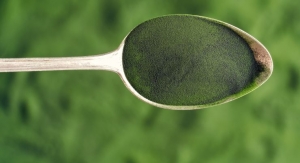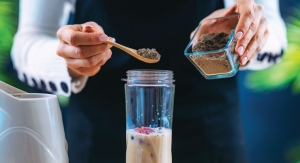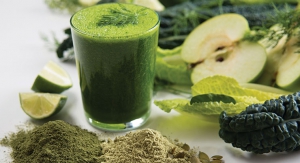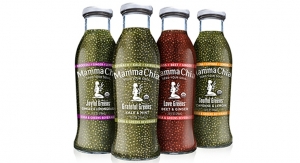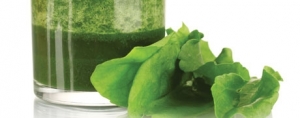Casey Adams, PhD05.02.11
While sales of many supplements have fallen or remained flat during the past few years, greenfood supplements have continued their steady rise into the hearts and minds—make that stomachs and bloodstreams—of consumers.
According to data provided by Jennifer Fuller of SPINS, Inc., combined retail channel wheat grass and barley grass sales are up 13% over last year (52 weeks ending February 20), the chlorophyll/chlorella category is up more than 13% and spirulina sales are up almost 7% over last year. More important, mass market sales are up significantly. Wheat/barley grasses were up 19% in the conventional channel, chlorophyll/chlorella sales were up more than 21% and other algae sales have more than doubled from a year ago.
This mass consumer growth during times when many have tightened their spending illustrates the value proposition made by greenfoods. “Quality green food supplements are important to the consumer because greenfoods are the one dietary area lacking in almost everyone’s diet,” said Ron Seibold, president and CEO, Lawrence, KS-based Pines International.
Greenfoods provide practically every nutrient imaginable, including enzymes, minerals, trace elements, essential and non-essential amino acids, vitamins, antioxidants and various phytonutrients. “Most greenfoods provide at least 1000 nutrients that are lacking in many modern diets,” explained Dave Sandoval, founder of greenfoods supplier Organic By Nature, Inc., Long Beach, CA. “Greenfoods are not like isolated synthetic nutrients. They are ancient foods with qualities to feed the world.”
A big benefit of greenfoods is their alkalinity. “Acidosis is a major health concern for the vast majority of western nations because of lifestyle and diet choices. Industrialized diets include acidic or acidifying elements such as meat, cereals, coffee, tea, alcohol and sugars, and not enough alkaline foods such as vegetables,” said Jeff Wuagneux, president and CEO, RFI Ingredients, Blauvelt, NY, supplier of a range of greenfoods. “Countering acidification is as simple as reducing the acids the body is taking in, and increasing alkaline foods or alkaline supplements.”
Much of this alkalinity comes from greenfoods’ bioavailable mineral content. “Soil-based minerals are metallic and plant derived minerals are colloidal,” said Elmer Heinrich, president of Tulsa Oklahoma’s Liquid Assets, Inc., a supplier of plant derived minerals. “Metallic minerals are hydrophobic in nature, possessing a positive electrical charge. Plant derived minerals have been transformed by the plant into non-metallic, water-soluble colloidal minerals that are easier for the body to assimilate.”
Cereal Grasses
Wheat grass is the young grass of the wheat species, Triticum aestivum. In addition to a plethora of vitamins, minerals, amino acids, phytonutrients, metabolic enzymes—including superoxide dismutase and cytochrome oxidase—wheat grass maintains up to 70% chlorophyll.
Early research by Dr. Charles Schnabel, Dr. George Kohler and Dr. A.I. Virtanen in the 1925-1950 era found that cereal grasses like wheatgrass achieved their highest nutrient content at around 18 days—right before the first jointing.
The Pines Wheat Grass company continues to use this science to this day. “We grow and harvest our product in the manner used in the foundational research,” commented Pines’ Mr. Seibold, referring to Schnabel and Kohler’s 25 years of research. The Pines company launched its products in the U.S. in 1977. “We were the company that coined the term ‘Green Food,’” Mr. Seibold added.
Post-harvest handling is critical. “The method used to remove the moisture from the wheat grass is state-of-the-art and is the most gentle possible, resulting in wheat grass with maximum levels of enzymes, vitamins, beta-carotene, chlorophyll and phytonutrients,” Mr. Seibold explained.
Wheat grass can increase blood hemoglobin levels. In fact, wheat grass tablets decreased blood transfusion needs by 25% among 20 children requiring frequent blood transfusions in a recent study.
Sales of wheatgrass supplements have continued to grow steadily for Pines, according to Mr. Seibold. “Our sales have had solid or better growth every year for the past two decades, even with recent economic news, probably because people recognize the nutrition-per-penny value of wheat grass,” he said.
Barley grass powders are also enjoying steady growth. “We’ve continued to grow over the last few years, and so far, 2011 is growing even faster,” said Bill Atkinson of Green Foods Corporation, Oxnard, CA. Green Foods Corp. introduced its barley grass products to Japan in 1969 and to the U.S. in 1979.
“Yoshihide Hagiwara, MD, was the first to develop the process of producing juice powder from greenfoods,” Mr. Atkinson claims. “He held the patent for the process for 30 years.” Before finding his healthy stride in the greenfoods industry, Dr. Hagiwara ran a leading Japanese pharmaceutical company.
“Our barley grass is grown on the North Pacific island of Keshu in fertile volcanic soil, giving our grass optimal nutrients,” Mr. Atkinson continued.
In fact, research has found that barley grass is a potent free radical scavenger; significantly reduces total cholesterol and LDL-cholesterol; and inhibits LDL oxidation.
As Mr. Atkinson pointed out, the nutrient and antioxidant potency may have something to do with this: “Our barley grass juice powder has at least 14 vitamins, 18 amino acids, 15 enzymes, 10 antioxidants, 18 minerals and 75 trace elements.”
Greenfoods Corporation juices its barley first. “The juice is then gently spray-dried at low temperatures to retain nutrients and enzymes,” Mr. Atkinson explained. “Because enzymes are hydrolases, they are retained during juicing and spray-drying. They hold their activity when rehydrated.”
Customers can find both dried leaf powders and juice powders in the marketplace. “Juice powder nutrients are a lot more bioavailable because the plant cell walls are broken down during juicing,” Mr. Atkinson said, adding, “Leaf powder is dried first, leaving more fiber content, but since some of the nutrients are trapped inside the cell walls, they are less [bio]available.”
Another cereal grass rising to prominence is Kamut grass. According to the Kamut International company of Missoula, MT, the Kamut brand khorasan wheat has higher protein levels than most wheat varieties, and contains higher zinc, selenium and magnesium content. Selenium is known for stimulating glutathione activity.
The Kamut variety is also being preserved for future generations. “The Kamut trademark guarantees the preservation of the ancient khorasan wheat variety: it will never be hybridized or genetically modified,” said Trevor Blyth, CEO of Kamut International, owner of the Kamut trademark. “The variety will always be grown certified organic with high standards for nutrition and purity.”
Consumers and manufacturers are beginning to recognize these benefits. “In 2010, we saw total annual growth of almost 40%, which was due in large part to consumers looking for high quality, nutritious alternatives to modern wheat,” Mr. Blyth said.
One Kamut license-holder and producer of Kamut grass powders is Liquadry of Abraham, UT. “Our Kamut juice powders and other cereal grasses are produced using our proprietary Ever-Raw process,” said Liquadry’s president, Elend LeBaron. “This enables us to classify our juice powders as ‘raw’ because processing temperatures never exceed 106 Fahrenheit.”
Mr. LeBaron has watched his company’s sales of Kamut and other cereal grass powders soar during the past few years. In fact, he said, “Our biggest growth has occurred since the recession began.”
Aloe Vera
While aloe has long been known for its skin irritation and wound-healing abilities, science on its internal use is still emerging.
According to Jeff Barrie of Aloecorp, Lacey, WA, “Consumers drink Aloe vera for gastrointestinal health, immune support and to help maintain healthy cardiovascular systems. Another growing use for aloe is for nutricosmetics.”
As another example, aloe may also help prevent kidney stones. A study published in the Journal of the Thailand Medical Association found that 200 grams of fresh aloe gel a day significantly decreased urinary oxalate excretion.
In addition, a study from London’s Queen Mary School of Medicine on 44 active ulcerated colitis patients found that internal aloe use resulted in clinical improvement. And double-blind, randomized research using Aloecorp’s Qmatrix processed aloe has shown that it reduces oxidative stress markers and stimulates the immune system.
Reaching a significant milestone, Aloecorp recently completed GRAS (Generally Recognized As Safe) certification for its aloe. “We are very excited about the future since more and more consumers are discovering the benefits of drinking Aloe vera,” Mr. Barrie commented.
Green Sprouts
Virtually ignored for many years as a supplement, sprout powders are now becoming heralded as nutritional greenfood powerhouses. “Sprouts have exponential nutritional value, far greater than those of the seeds or the fully-grown plants,” said Steven Lattey, director of raw materials for Moab, UT, sprout and cereal grass juice powders supplier, The Synergy Company.
This was confirmed in 1970s experiments by former Hippocrates Health Institute director of research, Viktoras Kulvinskas, MS, who found that ascorbic acid levels in soybean sprouts increased from zero to 103 mg per 100 grams by day six—about the ascorbic acid content found in lime juice. These levels fall off significantly within days.
Each plant has a different nutrient peak. Ascorbic acid content in broad bean sprouts—used to cure scurvy during World War I—peaks in three days, after which the levels fall off.
“The sprout appears to produce greater antioxidant levels as a defense mechanism against threats from the soil,” Mr. Lattey explained.
The Synergy Company supplies a host of sprouts, ranging from bean sprouts to wheat grass sprouts. Cruciferous sprouts such as broccoli and cabbage are also becoming more popular, according to Mr. Lattey. “These provide an extraordinary class of nutrients called glucosinolates. Glucosinolates yield sulfur compounds and indole-3 carbinols. These have been studied for their anti-tumor and anti-inflammatory benefits,” he said.
Nutrient availability requires exacting sprouting techniques. “Proper sprouting requires accurate seed selection because unsprouted seeds spoil overall nutrient content,” Mr. Lattey offered. “Most seeds have about a 30% germination rate. We hand select specialty heirloom seeds that have a 98% germination rate.”
The Synergy Company uses a special milling and flash freezing technique to preserve the nutrient content of its sprout powders. “We utilize an oxygen barrier process that helps prevent oxidation and nutrient loss,” added Mr. Lattey.
Sea Grasses
Kelps might be called “seaweeds,” but these phytonutrient powerhouses are anything but “weeds.” About 1500 species of sea kelps flourish, many in the North Pacific and North Atlantic oceans.
Most kelps are stationary, and sustainably harvested in the wild. This means they must be allowed to regrow to guarantee future harvests. “Wild harvested kelp can be certified organic under the USDA NOP Regulation §205.207, which addresses wild-crop harvesting practices,” said Bill Wolf, president of kelp producer Thorvin, Inc., New Castle, VA. “’Organic Certified’ kelp from Thorvin is harvested sustainably in a pristine Icelandic fjord.”
Thorvin’s Ascophyllum nodosum kelp contains an impressive array of vitamins—more than many vegetables. “Kelp delivers over 60 essential minerals, amino acids, vitamins and growth promoters,” said Mr. Wolf.
Most kelps also contain fucoidan, a sulfated polysaccharide. Laboratory studies have indicated fucoidan has anti-tumor, anticoagulant and anti-angiogenic effects. It also down-regulates Th2 (inhibiting allergic response), inhibits beta-amyloid formation (implicated in Alzheimer’s), inhibits proteinuria in Heymann nephritis and decreases artery platelet deposits.
Preserving these nutrients in kelp is an important consideration. “Thorvin kelp is carefully dried at low temperatures using geothermal energy, which preserves its nutrient density,” Mr. Wolf explained.
Draco Natural Products of San Jose, CA is another producer of kelp and other seaweeds. “We extract our sea vegetables using a water-only extraction process. Our extraction process is a closed system using proprietary technology to break open plant cell walls to release the actives,” said Brien Quirk, Draco’s director of R&D. “Water is superior in extracting compounds insoluble in a hydroalcoholic extraction, such as polysaccharides, flavonoid glycosides and more polar compounds.”
Draco produces powders of kelp, sargassi seaweed, Undaria pinnatifida, sea palm and others.
Thorvin and Draco’s sea vegetable sales have continued to rise, even through the recession. “Thorvin’s sales have grown at an annualized average of more than 20% over the last decade—with higher growth anticipated this year. We sell well in excess of 1000 tons per year,” Mr. Wolf offered.
Spirulina
Spirulina use dates back to the Aztecs. A good source of carotenoids, vitamins (including vegan B12 according to independent laboratory tests) and minerals, spirulina contains all essential and most non-essential amino acids, with up to 65% protein by weight. It also contains antioxidant phytonutrients such as zeaxanthin, myxoxanthophyll and lutein. “Spirulina contains a high level of antioxidant carotenoids, vitamins and minerals. It also contains a unique blue pigment, phycobiliprotein, which is only found in blue-green algae,” said Gerald Cysewski, PhD, founder and chief science officer, Hawaii-based Cyanotech.
“These phycocyanins in spirulina provide significant anti-inflammatory and antioxidant effects,” said Earthrise’s (Irvine, CA) chief technology officer, Amha Belay, PhD.
More specifically, Mr. Cysewski said, “Phycobiliproteins have been shown to protect both the liver and kidney from toxins. In addition, spirulina contains anti-viral compounds and compounds that stimulate the immune system.”
The two leading U.S. spirulina producers are Earthrise and Cyanotech. Earthrise produces its spirulina in sun-drenched Southern California, while Cyanotech produces theirs on the Big Island of Hawaii.
Both grow spirulina in huge volumes. According to Dr. Belay, Earthrise’s produces more than 400 tons per year, with demand continuing to increase.
Both producers are concerned about the quality of imported spirulinas, which is why cultivation techniques are tantamount. “Our ponds are all lined, and have no contact with soil,” said Dr. Belay. “Soil contact increases contaminants and heavy metals in the final product. [Companies] should assure their spirulina is coming from a lined pond with no soil contact.”
“We are one of few spirulina producers with a HACCP program,” Dr. Belay continued. “Our company and Cyanotech are also the only spirulina producers that have achieved FDA GRAS status. Other spirulina producers may have internally-developed GRAS documentation, but not necessarily reviewed by FDA.”
Dr. Belay suggested commercial buyers test their spirulina periodically. “Our tests have shown that some imported spirulinas have higher quantities of heavy metals and insect fragments, and reduced nutrient profiles,” he said. Cyanotech recently announced a laboratory study finding one offshore source had seven times the lead of its spirulina.
“Hawaiian spirulina has been evolving into a superior strain over the past 25 years. Continuous cultivation, along with a patented Ocean Chill Drying method, helps protect the fragile nutrients in Hawaiian spirulina,” Dr. Cysewski noted.
Hawaiian spirulina was used in a new study from the University of California-Davis on 30 adults over 50 years of age. After 12 weeks of 3000 mg of spirulina per day, hemoglobin concentration and mean corpuscular hemoglobin levels were higher among the subjects. IDO (indoleamine 2,3-dioxygenase) enzyme activity—a sign of increased immune function—was also higher among the subjects.
E3Live, Klamath Falls, OR, has developed a (patent-pending) process to extract the phycocyanins from spirulina. “Our process utilizes mechanical extraction methods rather than the synthetic extraction used elsewhere,” said E3Live’s CEO Tamera Campbell. The translucent blue E3Live product is called Blue Magic.
“This is the only natural blue coloring food dye available, and we are in the process of completing our GRAS certification,” she added.
Both Earthrise and Cyanotech report that their spirulina sales have continued their steady rise. In fact, Cyanotech’s president and CEO Brent Bailey announced recently that its branded spirulina sales increased 25% last quarter.
Chlorella
More than 800 published studies have verified the safety and efficacy of Chlorella pyrenoidosa. Chlorella’s reputation of drawing out heavy metals and other toxins make it a favorite among health practitioners.
Chlorella maintains considerable vitamins, minerals and phytonutrients—including chlorella growth factor (CGF), known to stimulate cell growth. It is also a complete protein, with about 60% protein by weight and every essential and non-essential amino acid. Clinical studies have shown that chlorella stimulates T-cell and B-cell activity and contributes to the improvement of fibromyalgia, ulcerative colitis and hypertension. Another study showed that chlorella increases IgA levels and lowers dioxin levels in breast milk.
Torrance, CA-based Sun Chlorella is a leading producer. “We harvest our product in fresh water under pristine conditions to ensure maximum quality,” said Guinevere Lynn, director of business development. “One of the most unique qualities of chlorella is its ability to replicate at an extremely high rate.”
“As chlorella multiplies, it is transferred into progressively larger outdoor pools,” Ms. Lynn continued. “Eventually, it is placed in the largest of the culturing pools, 36 meters in diameter. The water originates from 3000 meter-high mountains. The chlorella is constantly stirred to ensure maximum sunlight exposure. Repeated centrifuging separates out foreign elements.”
Chlorella’s tough cell wall must be broken down mechanically to allow these nutrients bioavailability. “Chlorella cannot be fully digested in its native form by human digestive enzymes,” explained Ms. Lynn. “Our patented process pulverizes this tough outer cell wall, allowing maximum bioavailability and digestibility of the nutrients.”
Haematococcus and Astaxanthin
Another rising microalga is Haematococcus pluvialis, known for its high astaxanthin content. “Astaxanthin is a carotenoid pigment similar to beta-carotene—and the most abundant carotenoid in the marine environment,” said Cyanotech’s Dr. Cysewski.
“Astaxanthin has been shown to be the most powerful natural antioxidant known; it also has anti-inflammatory properties. As such, it can address a number of health issues, including joint and muscle soreness, cardiovascular health, eye health and even skin health, as it can protect against damage by UV radiation,” Dr. Cysewski added.
Charles DePrince, president and CEO of astaxanthin producer Fuji Health Science, Mt. Laurel, NJ, said his company has sponsored more than 50 research studies on astaxanthin during the past 10 years. “The strongest bodies of research include eye fatigue, cardiovascular health and muscle endurance,” he stated.
“When Haematococcus becomes stressed it begins to accumulate large amounts of astaxanthin,” Dr. Cysewski said.
“It produces high levels of astaxanthin just prior to entering its hibernation state,” Mr. DePrince added. “The natural purpose of the astaxanthin content within the alga is to protect it from lipid peroxidation.”
In contrast to Cyanotech’s outdoor cultivation, Fuji’s cultivation process consists of fully enclosed biosystems located in Gustavsberg, Sweden. “Following cultivation, the alga is harvested, dried and extracted via a solvent-free CO2 supercritical process,” noted Mr. DePrince.
Both Fuji and Cyanotech report continued sales growth through the recession. “We have seen a sharp increase in the growth of sales over the past six months in response to what we feel is the reaching of critical mass in research and resulting recognition of the value of natural astaxanthin,” Mr. DePrince opined.
Further, Dr. Cysewski added, “Health practitioners and consumers are beginning to learn about the many positive benefits of astaxanthin.” Cyanotech announced 40% sales growth in branded astaxanthin last quarter.
Blue-Green Algae from Klamath Lake
Aphanizomenon flos-aquae, or AFA, grows on the pristine waters of Klamath Lake in Oregon. Commercial AFA harvesting began in the early 1980s.
“The rich volcanic Klamath Lake renders our product a good source of protein, with all the essential and non-essential amino acids, as well as many vitamins, minerals and phytonutrients,” said Ms. Campbell of E3Live. AFA contains about 60% protein by weight, and at least 58 minerals at ppm levels, along with significant chlorophyll content.
One of the more exciting phytonutrient compounds discovered in AFA is phenylethylamine (PEA). “PEA is often called the ‘love molecule,’ because it increases positive moods. It is found in foods like chocolate—though AFA contains significantly more than chocolate,” explained Ms. Campbell.
The E3Live company recently developed a product with enhanced levels of PEA, called BrainON. “BrainON improves brain function and mood, and neuro-enhancement overall,” Ms. Campbell said.
“E3Live’s flagship products are fresh frozen, leaving nutrients biologically available. But for long-term shelf life we use a proprietary method of low-heat drying called Hydro-drying, which retains the viability of nutrients and enzymes within the product,” she said.
E3Live’s AFA sales have been steadily increasing despite the recession. Ms. Campbell said the company’s customers use it in functional beverages, snacks, greenfood mixes and others.
Fermented Greenfoods
This significant effort among greenfood producers to retain nutrients through innovative processing techniques continues to render innovation. One recent innovation is fermentation.
RFI Ingredients has developed a unique system of greenfood fermentation. “Fermentation naturally breaks down the nutrients in greenfoods by the action of beneficial microorganisms. The fermented greenfoods are easier to digest, have more nutrients, and are preserved longer,” said Mr. Wuagneux. “We can ferment numerous ingredients, from cereal grasses to fruits and vegetables. In addition to improved nutrient bioavailability, these fermented greens have the added benefit of probiotic bacteria, which help restore and balance intestinal microflora.”
The Rise of the Green Sun
The green sun is still rising on the market, with plenty of upward sky to traverse. This comes from the fact that greenfoods resolve fundamental dietary deficiencies.
“Even after 35 years of spreading the message of ‘eat more green,’ the average modern diet is still lacking in these foods. Retailers need to look at greenfoods as a staple in the diet. They are foundation supplements that customers should be using before they use anything else,” Pine’s Mr. Seibold concluded.
About the author: A longtime advocate of greenfoods, Casey Adams is a California Naturopath with a PhD in Natural Health Sciences, and the author of several books on natural health. Dr. Adams is also the president of Realnatural, Inc. and can be contacted at ca@caseadams.com.
Previous encounters with nuclear disasters may prepare greenfoods companies to help Japan deal with potential radiation incidents.
With the recent Japanese nuclear crisis, there is good reason (and science) to believe that greenfoods may offer a possible defense against the effects of radiation.
Iodine is one reason for this. “Kelp is a natural source of iodine and it has long been used to boost thyroid function,” said Bill Wolf, president of kelp producer, Thorvin, Inc., New Castle, VA. “This is not the first time Thorvin has seen an event-related spike in sales. Following the Chernobyl nuclear incident, people purchased kelp for themselves and their animals with the goal of protecting thyroid function.”
Brien Quirk, director of R&D, Draco Natural Products, San Jose, CA, explained some of the science behind iodine and kelp. “Recent interest with kelp as a source of iodine is to help protect against the danger of radioactive Iodine-131—the product of nuclear fallout or byproducts of the nuclear industry. If insufficient iodine is supplied by the diet, the thyroid will readily take up the radioactive isotope form, but if ample amounts of iodine in the safe range are ingested, the thyroid will not take up the dangerous form.
“Iodine-131 has been shown to cause thyroid cancer, which developed in thousands of children following the Chernobyl disaster. A preventative remedy called for ingesting larger amounts of iodine before exposure—almost 100 mg per day in the form of potassium iodide (KI). The danger here is that this can be toxic for most people if taken over a period of time, but kelp in lower dosages has been shown to supply bioavailable iodine in safe amounts, without the toxicity of the higher dosages of KI.”
But Mr. Quirk added a cautionary statement. “Large amounts of iodine should only be consumed under a doctor’s supervision or at the recommendation of the authorities if imminent exposure may otherwise occur. The safe upper limit for iodine is 1 mg per day under ordinary circumstances. The RDA for iodine requires only 150 micrograms.”
Thorvin’s Mr. Wolf has already seen kelp sales spike. “In response to the nuclear situation in Japan, Thorvin has seen an increase in sales to our distributors and formulators,” he said. “The Thorvin kelp blend is iodine-rich; moreover, it’s plant-based, so the iodine is bioavailable, making it particularly attractive to formulators and their customers at this time.”
Other research suggests that additional constituents in seaweeds may help protect against radioactive elements. A 1968 study from the Journal of the Canadian Medical Association showed that calcium alginate derivatives reduce radiostrontium levels in the body by binding to radioisotopes. The critical components of alginic acid appear to be D-mannuronic and L-guluronic acids. The researchers found that specific menuronic-guluronic acid ratios among different species reduced strontium levels to different degrees, and several kelps were classified in the “highly effective” group.
Amha Belay, PhD, chief technology officer, Earthrise Nutritionals, Irvine, CA, said spirulina research on people affected by the Chernobyl accident illustrates that it can also be helpful for the effects of radiation. “In research from Belarus, children affected by radiation were given 5 grams of Earthrise spirulina a day, which resulted in the reduction of Cesium-137 in their urine by 50%. The spirulina also decreased radionuclide radioaction dose load received from food contamination.”
“The c-phycocyanin and polysaccharide extracts of spirulina also stimulate recovery of white blood cells and bone marrow cell counts. These also can effect the anemic condition induced by irradiation,” Dr. Belay continued.
Cyanotech’s (Hawaii) Gerald Cysewski, PhD, also weighed in on spirulina’s anti-radiation effects. “Spirulina contains only a small amount of iodine, so I don’t believe this is the cause of spirulina’s protective properties. Rather, I think it is due to the high level of antioxidant carotenoids, which neutralize free radicals caused by radiation—the antioxidant phycobiliproteins in spirulina and polysaccharides in spirulina that chelate radioactive species and eliminate them from the body.”
In 1991, the Ministry of Health of Byelorussian SSR sent a letter to Earthrise Nutritionals requesting a donation of spirulina for the children of Chernobyl. The letter stated that the Byelorussian SSR had “concluded that Spirulina promotes to some extent evacuating radionuclides from the human body.” And the Ministry “considers it advisable to use spirulina for the treatment of people who were subject to radiation effects.” —CA
References
1. Singh K, Pannu MS, Singh P, Singh J. Effect of wheat grass tablets on the
frequency of blood transfusions in Thalassemia Major. Indian J Pediatr. 2010
Jan;77(1):90-1.
2. Liu WC, Tsai CE. Young Barley Leaf Prevents LDL Oxidation in Humans. Food Science and Agricultural Chemistry. Chin Inst Food Sci and Tech. 2002. 4(3):110-116.
3. Yu YM and Tsai CE. LDL cholesterol and oxidation are significantly reduced in type 2 diabetic patients receiving a barley leaf essence supplemented olive oil diet. Chin Inst Food Sci and Tech. 2003. 5(1):1-6.
4. Yu YM, Chang WC, Chang CT, Hsieh CL, and Tsai CE. Effects of barley leaf extract and antioxidative vitamins on LDL oxidation and free radical scavenging activities in type 2 diabetes. Diabetes Metab. 2002. 28(2):107-114.
5. Kirdpon S, Kirdpon W, Airarat W, Trevanich A, Nanakorn S. Effect of aloe (Aloe
vera Linn.) on healthy adult volunteers: changes in urinary composition. J Med
Assoc Thai. 2006 Aug;89 Suppl 2:S9-14.
6. Langmead L, Feakins RM, Goldthorpe S, Holt H, Tsironi E, De Silva A, Jewell
DP, Rampton DS. Randomized, double-blind, placebo-controlled trial of oral aloe
vera gel for active ulcerative colitis. Aliment Pharmacol Ther. 2004 Apr
1;19(7):739-47.
7. Korean Food and Drug Administration. A Single Center, Randomized, Double-Blind, Placebo Controlled Human Trial to Evaluate the Efficacy and Safety of Aloe regarding the Immunity Enhancing Effect (Phase IV Human Test). Not published, provided by Aloecorp, 2011.
8. Devaraj S. An 8-Week, Double-Blind, Placebo-Controlled Pilot Trial of the Safety and Effects of Qmatrix Aloe vera in Subjects with Pre-Diabetes/Metabolic Syndrome. Not published, provided by Aloecorp, 2008.
9. Kuznetsova TA, et al. 2004. Biological activity of fucoidans from brown algae and the prospects of their use in medicine. Antibiot Khimioter. 49(5):24-30.
10. Nagaoka M, et al. 2000. Anti-ulcer effects and biological activities of polysaccharides from marine algae. Biofactors. 12(1-4):267-74.
11. Berteau O and Mulloy B. 2003. Sulfated fucans, fresh perspectives: structures, functions, and biological properties of sulfated fucans and an overview of enzymes active toward this class of polysaccharide. Glycobiology. Jun;13(6):29R-40R.
12. Selmi C, Leung PS, Fischer L, German B, Yang CY, Kenny TP, Cysewski GR, Gershwin ME. The effects of Spirulina on anemia and immune function in senior citizens. Cell Mol Immunol. 2011 Jan 31.
13. Merchant RE and Andre CA. 2001. A review of recent clinical trials of the nutritional supplement Chlorella pyrenoidosa in the treatment of fibromyalgia, hypertension, and ulcerative colitis. Altern Ther Health Med. May-Jun;7(3):79-91.
14. Nakano S, Takekoshi H, Nakano M. Chlorella (Chlorella pyrenoidosa)
supplementation decreases dioxin and increases immunoglobulin a concentrations in
breast milk. J Med Food. 2007 Mar;10(1):134-42. PubMed PMID: 17472477.
Radiation Sidebar
Zozulia IS, Iurchenko AV. The adaptive potentials of those who worked in the cleanup of the aftermath of the accident at the Chernobyl Atomic Electric Power Station under the influence of different treatment methods. Lik Sprava. 2000 Apr-Jun;(3-4):18-21.
Karpov LM, Brown II, Poltavtseva NV, Ershova ON, Karakis SG, Vasil'eva TV, Chaban IuL. The postradiation use of vitamin-containing complexes and a phycocyanin extract in a radiation lesion in rats. Radiats Biol Radioecol. 2000 May-Jun;40(3):310-4.
Zhang HQ, Lin AP, Sun Y, Deng YM. Chemo- and radio-protective effects of polysaccharide of Spirulina platensis on hemopoietic system of mice and dogs. Acta Pharmacol Sin. 2001 Dec;22(12):1121-4.
Chen B, Zhou XC. Protective effect of natural dietary antioxidants on space radiation-induced damages. Space Med Med Eng (Beijing). 2003;16 Suppl:514-8.
Tanaka Y, Wadron-Edward D, Skoryna SC. Studies on Inhibition of Intestinal Absorption of Radiactive Strontium. Canad. Med. Ass. J. July 27, 1968, vol 99.
According to data provided by Jennifer Fuller of SPINS, Inc., combined retail channel wheat grass and barley grass sales are up 13% over last year (52 weeks ending February 20), the chlorophyll/chlorella category is up more than 13% and spirulina sales are up almost 7% over last year. More important, mass market sales are up significantly. Wheat/barley grasses were up 19% in the conventional channel, chlorophyll/chlorella sales were up more than 21% and other algae sales have more than doubled from a year ago.
This mass consumer growth during times when many have tightened their spending illustrates the value proposition made by greenfoods. “Quality green food supplements are important to the consumer because greenfoods are the one dietary area lacking in almost everyone’s diet,” said Ron Seibold, president and CEO, Lawrence, KS-based Pines International.
Greenfoods provide practically every nutrient imaginable, including enzymes, minerals, trace elements, essential and non-essential amino acids, vitamins, antioxidants and various phytonutrients. “Most greenfoods provide at least 1000 nutrients that are lacking in many modern diets,” explained Dave Sandoval, founder of greenfoods supplier Organic By Nature, Inc., Long Beach, CA. “Greenfoods are not like isolated synthetic nutrients. They are ancient foods with qualities to feed the world.”
A big benefit of greenfoods is their alkalinity. “Acidosis is a major health concern for the vast majority of western nations because of lifestyle and diet choices. Industrialized diets include acidic or acidifying elements such as meat, cereals, coffee, tea, alcohol and sugars, and not enough alkaline foods such as vegetables,” said Jeff Wuagneux, president and CEO, RFI Ingredients, Blauvelt, NY, supplier of a range of greenfoods. “Countering acidification is as simple as reducing the acids the body is taking in, and increasing alkaline foods or alkaline supplements.”
Much of this alkalinity comes from greenfoods’ bioavailable mineral content. “Soil-based minerals are metallic and plant derived minerals are colloidal,” said Elmer Heinrich, president of Tulsa Oklahoma’s Liquid Assets, Inc., a supplier of plant derived minerals. “Metallic minerals are hydrophobic in nature, possessing a positive electrical charge. Plant derived minerals have been transformed by the plant into non-metallic, water-soluble colloidal minerals that are easier for the body to assimilate.”
Cereal Grasses
Wheat grass is the young grass of the wheat species, Triticum aestivum. In addition to a plethora of vitamins, minerals, amino acids, phytonutrients, metabolic enzymes—including superoxide dismutase and cytochrome oxidase—wheat grass maintains up to 70% chlorophyll.
Early research by Dr. Charles Schnabel, Dr. George Kohler and Dr. A.I. Virtanen in the 1925-1950 era found that cereal grasses like wheatgrass achieved their highest nutrient content at around 18 days—right before the first jointing.
The Pines Wheat Grass company continues to use this science to this day. “We grow and harvest our product in the manner used in the foundational research,” commented Pines’ Mr. Seibold, referring to Schnabel and Kohler’s 25 years of research. The Pines company launched its products in the U.S. in 1977. “We were the company that coined the term ‘Green Food,’” Mr. Seibold added.
Post-harvest handling is critical. “The method used to remove the moisture from the wheat grass is state-of-the-art and is the most gentle possible, resulting in wheat grass with maximum levels of enzymes, vitamins, beta-carotene, chlorophyll and phytonutrients,” Mr. Seibold explained.
Wheat grass can increase blood hemoglobin levels. In fact, wheat grass tablets decreased blood transfusion needs by 25% among 20 children requiring frequent blood transfusions in a recent study.
Sales of wheatgrass supplements have continued to grow steadily for Pines, according to Mr. Seibold. “Our sales have had solid or better growth every year for the past two decades, even with recent economic news, probably because people recognize the nutrition-per-penny value of wheat grass,” he said.
Barley grass powders are also enjoying steady growth. “We’ve continued to grow over the last few years, and so far, 2011 is growing even faster,” said Bill Atkinson of Green Foods Corporation, Oxnard, CA. Green Foods Corp. introduced its barley grass products to Japan in 1969 and to the U.S. in 1979.
“Yoshihide Hagiwara, MD, was the first to develop the process of producing juice powder from greenfoods,” Mr. Atkinson claims. “He held the patent for the process for 30 years.” Before finding his healthy stride in the greenfoods industry, Dr. Hagiwara ran a leading Japanese pharmaceutical company.
“Our barley grass is grown on the North Pacific island of Keshu in fertile volcanic soil, giving our grass optimal nutrients,” Mr. Atkinson continued.
In fact, research has found that barley grass is a potent free radical scavenger; significantly reduces total cholesterol and LDL-cholesterol; and inhibits LDL oxidation.
As Mr. Atkinson pointed out, the nutrient and antioxidant potency may have something to do with this: “Our barley grass juice powder has at least 14 vitamins, 18 amino acids, 15 enzymes, 10 antioxidants, 18 minerals and 75 trace elements.”
Greenfoods Corporation juices its barley first. “The juice is then gently spray-dried at low temperatures to retain nutrients and enzymes,” Mr. Atkinson explained. “Because enzymes are hydrolases, they are retained during juicing and spray-drying. They hold their activity when rehydrated.”
Customers can find both dried leaf powders and juice powders in the marketplace. “Juice powder nutrients are a lot more bioavailable because the plant cell walls are broken down during juicing,” Mr. Atkinson said, adding, “Leaf powder is dried first, leaving more fiber content, but since some of the nutrients are trapped inside the cell walls, they are less [bio]available.”
Another cereal grass rising to prominence is Kamut grass. According to the Kamut International company of Missoula, MT, the Kamut brand khorasan wheat has higher protein levels than most wheat varieties, and contains higher zinc, selenium and magnesium content. Selenium is known for stimulating glutathione activity.
The Kamut variety is also being preserved for future generations. “The Kamut trademark guarantees the preservation of the ancient khorasan wheat variety: it will never be hybridized or genetically modified,” said Trevor Blyth, CEO of Kamut International, owner of the Kamut trademark. “The variety will always be grown certified organic with high standards for nutrition and purity.”
Consumers and manufacturers are beginning to recognize these benefits. “In 2010, we saw total annual growth of almost 40%, which was due in large part to consumers looking for high quality, nutritious alternatives to modern wheat,” Mr. Blyth said.
One Kamut license-holder and producer of Kamut grass powders is Liquadry of Abraham, UT. “Our Kamut juice powders and other cereal grasses are produced using our proprietary Ever-Raw process,” said Liquadry’s president, Elend LeBaron. “This enables us to classify our juice powders as ‘raw’ because processing temperatures never exceed 106 Fahrenheit.”
Mr. LeBaron has watched his company’s sales of Kamut and other cereal grass powders soar during the past few years. In fact, he said, “Our biggest growth has occurred since the recession began.”
Aloe Vera
While aloe has long been known for its skin irritation and wound-healing abilities, science on its internal use is still emerging.
According to Jeff Barrie of Aloecorp, Lacey, WA, “Consumers drink Aloe vera for gastrointestinal health, immune support and to help maintain healthy cardiovascular systems. Another growing use for aloe is for nutricosmetics.”
As another example, aloe may also help prevent kidney stones. A study published in the Journal of the Thailand Medical Association found that 200 grams of fresh aloe gel a day significantly decreased urinary oxalate excretion.
In addition, a study from London’s Queen Mary School of Medicine on 44 active ulcerated colitis patients found that internal aloe use resulted in clinical improvement. And double-blind, randomized research using Aloecorp’s Qmatrix processed aloe has shown that it reduces oxidative stress markers and stimulates the immune system.
Reaching a significant milestone, Aloecorp recently completed GRAS (Generally Recognized As Safe) certification for its aloe. “We are very excited about the future since more and more consumers are discovering the benefits of drinking Aloe vera,” Mr. Barrie commented.
Green Sprouts
Virtually ignored for many years as a supplement, sprout powders are now becoming heralded as nutritional greenfood powerhouses. “Sprouts have exponential nutritional value, far greater than those of the seeds or the fully-grown plants,” said Steven Lattey, director of raw materials for Moab, UT, sprout and cereal grass juice powders supplier, The Synergy Company.
This was confirmed in 1970s experiments by former Hippocrates Health Institute director of research, Viktoras Kulvinskas, MS, who found that ascorbic acid levels in soybean sprouts increased from zero to 103 mg per 100 grams by day six—about the ascorbic acid content found in lime juice. These levels fall off significantly within days.
Each plant has a different nutrient peak. Ascorbic acid content in broad bean sprouts—used to cure scurvy during World War I—peaks in three days, after which the levels fall off.
“The sprout appears to produce greater antioxidant levels as a defense mechanism against threats from the soil,” Mr. Lattey explained.
The Synergy Company supplies a host of sprouts, ranging from bean sprouts to wheat grass sprouts. Cruciferous sprouts such as broccoli and cabbage are also becoming more popular, according to Mr. Lattey. “These provide an extraordinary class of nutrients called glucosinolates. Glucosinolates yield sulfur compounds and indole-3 carbinols. These have been studied for their anti-tumor and anti-inflammatory benefits,” he said.
Nutrient availability requires exacting sprouting techniques. “Proper sprouting requires accurate seed selection because unsprouted seeds spoil overall nutrient content,” Mr. Lattey offered. “Most seeds have about a 30% germination rate. We hand select specialty heirloom seeds that have a 98% germination rate.”
The Synergy Company uses a special milling and flash freezing technique to preserve the nutrient content of its sprout powders. “We utilize an oxygen barrier process that helps prevent oxidation and nutrient loss,” added Mr. Lattey.
Sea Grasses
Kelps might be called “seaweeds,” but these phytonutrient powerhouses are anything but “weeds.” About 1500 species of sea kelps flourish, many in the North Pacific and North Atlantic oceans.
Most kelps are stationary, and sustainably harvested in the wild. This means they must be allowed to regrow to guarantee future harvests. “Wild harvested kelp can be certified organic under the USDA NOP Regulation §205.207, which addresses wild-crop harvesting practices,” said Bill Wolf, president of kelp producer Thorvin, Inc., New Castle, VA. “’Organic Certified’ kelp from Thorvin is harvested sustainably in a pristine Icelandic fjord.”
Thorvin’s Ascophyllum nodosum kelp contains an impressive array of vitamins—more than many vegetables. “Kelp delivers over 60 essential minerals, amino acids, vitamins and growth promoters,” said Mr. Wolf.
Most kelps also contain fucoidan, a sulfated polysaccharide. Laboratory studies have indicated fucoidan has anti-tumor, anticoagulant and anti-angiogenic effects. It also down-regulates Th2 (inhibiting allergic response), inhibits beta-amyloid formation (implicated in Alzheimer’s), inhibits proteinuria in Heymann nephritis and decreases artery platelet deposits.
Preserving these nutrients in kelp is an important consideration. “Thorvin kelp is carefully dried at low temperatures using geothermal energy, which preserves its nutrient density,” Mr. Wolf explained.
Draco Natural Products of San Jose, CA is another producer of kelp and other seaweeds. “We extract our sea vegetables using a water-only extraction process. Our extraction process is a closed system using proprietary technology to break open plant cell walls to release the actives,” said Brien Quirk, Draco’s director of R&D. “Water is superior in extracting compounds insoluble in a hydroalcoholic extraction, such as polysaccharides, flavonoid glycosides and more polar compounds.”
Draco produces powders of kelp, sargassi seaweed, Undaria pinnatifida, sea palm and others.
Thorvin and Draco’s sea vegetable sales have continued to rise, even through the recession. “Thorvin’s sales have grown at an annualized average of more than 20% over the last decade—with higher growth anticipated this year. We sell well in excess of 1000 tons per year,” Mr. Wolf offered.
Spirulina
Spirulina use dates back to the Aztecs. A good source of carotenoids, vitamins (including vegan B12 according to independent laboratory tests) and minerals, spirulina contains all essential and most non-essential amino acids, with up to 65% protein by weight. It also contains antioxidant phytonutrients such as zeaxanthin, myxoxanthophyll and lutein. “Spirulina contains a high level of antioxidant carotenoids, vitamins and minerals. It also contains a unique blue pigment, phycobiliprotein, which is only found in blue-green algae,” said Gerald Cysewski, PhD, founder and chief science officer, Hawaii-based Cyanotech.
“These phycocyanins in spirulina provide significant anti-inflammatory and antioxidant effects,” said Earthrise’s (Irvine, CA) chief technology officer, Amha Belay, PhD.
More specifically, Mr. Cysewski said, “Phycobiliproteins have been shown to protect both the liver and kidney from toxins. In addition, spirulina contains anti-viral compounds and compounds that stimulate the immune system.”
The two leading U.S. spirulina producers are Earthrise and Cyanotech. Earthrise produces its spirulina in sun-drenched Southern California, while Cyanotech produces theirs on the Big Island of Hawaii.
Both grow spirulina in huge volumes. According to Dr. Belay, Earthrise’s produces more than 400 tons per year, with demand continuing to increase.
Both producers are concerned about the quality of imported spirulinas, which is why cultivation techniques are tantamount. “Our ponds are all lined, and have no contact with soil,” said Dr. Belay. “Soil contact increases contaminants and heavy metals in the final product. [Companies] should assure their spirulina is coming from a lined pond with no soil contact.”
“We are one of few spirulina producers with a HACCP program,” Dr. Belay continued. “Our company and Cyanotech are also the only spirulina producers that have achieved FDA GRAS status. Other spirulina producers may have internally-developed GRAS documentation, but not necessarily reviewed by FDA.”
Dr. Belay suggested commercial buyers test their spirulina periodically. “Our tests have shown that some imported spirulinas have higher quantities of heavy metals and insect fragments, and reduced nutrient profiles,” he said. Cyanotech recently announced a laboratory study finding one offshore source had seven times the lead of its spirulina.
“Hawaiian spirulina has been evolving into a superior strain over the past 25 years. Continuous cultivation, along with a patented Ocean Chill Drying method, helps protect the fragile nutrients in Hawaiian spirulina,” Dr. Cysewski noted.
Hawaiian spirulina was used in a new study from the University of California-Davis on 30 adults over 50 years of age. After 12 weeks of 3000 mg of spirulina per day, hemoglobin concentration and mean corpuscular hemoglobin levels were higher among the subjects. IDO (indoleamine 2,3-dioxygenase) enzyme activity—a sign of increased immune function—was also higher among the subjects.
E3Live, Klamath Falls, OR, has developed a (patent-pending) process to extract the phycocyanins from spirulina. “Our process utilizes mechanical extraction methods rather than the synthetic extraction used elsewhere,” said E3Live’s CEO Tamera Campbell. The translucent blue E3Live product is called Blue Magic.
“This is the only natural blue coloring food dye available, and we are in the process of completing our GRAS certification,” she added.
Both Earthrise and Cyanotech report that their spirulina sales have continued their steady rise. In fact, Cyanotech’s president and CEO Brent Bailey announced recently that its branded spirulina sales increased 25% last quarter.
Chlorella
More than 800 published studies have verified the safety and efficacy of Chlorella pyrenoidosa. Chlorella’s reputation of drawing out heavy metals and other toxins make it a favorite among health practitioners.
Chlorella maintains considerable vitamins, minerals and phytonutrients—including chlorella growth factor (CGF), known to stimulate cell growth. It is also a complete protein, with about 60% protein by weight and every essential and non-essential amino acid. Clinical studies have shown that chlorella stimulates T-cell and B-cell activity and contributes to the improvement of fibromyalgia, ulcerative colitis and hypertension. Another study showed that chlorella increases IgA levels and lowers dioxin levels in breast milk.
Torrance, CA-based Sun Chlorella is a leading producer. “We harvest our product in fresh water under pristine conditions to ensure maximum quality,” said Guinevere Lynn, director of business development. “One of the most unique qualities of chlorella is its ability to replicate at an extremely high rate.”
“As chlorella multiplies, it is transferred into progressively larger outdoor pools,” Ms. Lynn continued. “Eventually, it is placed in the largest of the culturing pools, 36 meters in diameter. The water originates from 3000 meter-high mountains. The chlorella is constantly stirred to ensure maximum sunlight exposure. Repeated centrifuging separates out foreign elements.”
Chlorella’s tough cell wall must be broken down mechanically to allow these nutrients bioavailability. “Chlorella cannot be fully digested in its native form by human digestive enzymes,” explained Ms. Lynn. “Our patented process pulverizes this tough outer cell wall, allowing maximum bioavailability and digestibility of the nutrients.”
Haematococcus and Astaxanthin
Another rising microalga is Haematococcus pluvialis, known for its high astaxanthin content. “Astaxanthin is a carotenoid pigment similar to beta-carotene—and the most abundant carotenoid in the marine environment,” said Cyanotech’s Dr. Cysewski.
“Astaxanthin has been shown to be the most powerful natural antioxidant known; it also has anti-inflammatory properties. As such, it can address a number of health issues, including joint and muscle soreness, cardiovascular health, eye health and even skin health, as it can protect against damage by UV radiation,” Dr. Cysewski added.
Charles DePrince, president and CEO of astaxanthin producer Fuji Health Science, Mt. Laurel, NJ, said his company has sponsored more than 50 research studies on astaxanthin during the past 10 years. “The strongest bodies of research include eye fatigue, cardiovascular health and muscle endurance,” he stated.
“When Haematococcus becomes stressed it begins to accumulate large amounts of astaxanthin,” Dr. Cysewski said.
“It produces high levels of astaxanthin just prior to entering its hibernation state,” Mr. DePrince added. “The natural purpose of the astaxanthin content within the alga is to protect it from lipid peroxidation.”
In contrast to Cyanotech’s outdoor cultivation, Fuji’s cultivation process consists of fully enclosed biosystems located in Gustavsberg, Sweden. “Following cultivation, the alga is harvested, dried and extracted via a solvent-free CO2 supercritical process,” noted Mr. DePrince.
Both Fuji and Cyanotech report continued sales growth through the recession. “We have seen a sharp increase in the growth of sales over the past six months in response to what we feel is the reaching of critical mass in research and resulting recognition of the value of natural astaxanthin,” Mr. DePrince opined.
Further, Dr. Cysewski added, “Health practitioners and consumers are beginning to learn about the many positive benefits of astaxanthin.” Cyanotech announced 40% sales growth in branded astaxanthin last quarter.
Blue-Green Algae from Klamath Lake
Aphanizomenon flos-aquae, or AFA, grows on the pristine waters of Klamath Lake in Oregon. Commercial AFA harvesting began in the early 1980s.
“The rich volcanic Klamath Lake renders our product a good source of protein, with all the essential and non-essential amino acids, as well as many vitamins, minerals and phytonutrients,” said Ms. Campbell of E3Live. AFA contains about 60% protein by weight, and at least 58 minerals at ppm levels, along with significant chlorophyll content.
One of the more exciting phytonutrient compounds discovered in AFA is phenylethylamine (PEA). “PEA is often called the ‘love molecule,’ because it increases positive moods. It is found in foods like chocolate—though AFA contains significantly more than chocolate,” explained Ms. Campbell.
The E3Live company recently developed a product with enhanced levels of PEA, called BrainON. “BrainON improves brain function and mood, and neuro-enhancement overall,” Ms. Campbell said.
“E3Live’s flagship products are fresh frozen, leaving nutrients biologically available. But for long-term shelf life we use a proprietary method of low-heat drying called Hydro-drying, which retains the viability of nutrients and enzymes within the product,” she said.
E3Live’s AFA sales have been steadily increasing despite the recession. Ms. Campbell said the company’s customers use it in functional beverages, snacks, greenfood mixes and others.
Fermented Greenfoods
This significant effort among greenfood producers to retain nutrients through innovative processing techniques continues to render innovation. One recent innovation is fermentation.
RFI Ingredients has developed a unique system of greenfood fermentation. “Fermentation naturally breaks down the nutrients in greenfoods by the action of beneficial microorganisms. The fermented greenfoods are easier to digest, have more nutrients, and are preserved longer,” said Mr. Wuagneux. “We can ferment numerous ingredients, from cereal grasses to fruits and vegetables. In addition to improved nutrient bioavailability, these fermented greens have the added benefit of probiotic bacteria, which help restore and balance intestinal microflora.”
The Rise of the Green Sun
The green sun is still rising on the market, with plenty of upward sky to traverse. This comes from the fact that greenfoods resolve fundamental dietary deficiencies.
“Even after 35 years of spreading the message of ‘eat more green,’ the average modern diet is still lacking in these foods. Retailers need to look at greenfoods as a staple in the diet. They are foundation supplements that customers should be using before they use anything else,” Pine’s Mr. Seibold concluded.
About the author: A longtime advocate of greenfoods, Casey Adams is a California Naturopath with a PhD in Natural Health Sciences, and the author of several books on natural health. Dr. Adams is also the president of Realnatural, Inc. and can be contacted at ca@caseadams.com.
Previous encounters with nuclear disasters may prepare greenfoods companies to help Japan deal with potential radiation incidents.
With the recent Japanese nuclear crisis, there is good reason (and science) to believe that greenfoods may offer a possible defense against the effects of radiation.
Iodine is one reason for this. “Kelp is a natural source of iodine and it has long been used to boost thyroid function,” said Bill Wolf, president of kelp producer, Thorvin, Inc., New Castle, VA. “This is not the first time Thorvin has seen an event-related spike in sales. Following the Chernobyl nuclear incident, people purchased kelp for themselves and their animals with the goal of protecting thyroid function.”
Brien Quirk, director of R&D, Draco Natural Products, San Jose, CA, explained some of the science behind iodine and kelp. “Recent interest with kelp as a source of iodine is to help protect against the danger of radioactive Iodine-131—the product of nuclear fallout or byproducts of the nuclear industry. If insufficient iodine is supplied by the diet, the thyroid will readily take up the radioactive isotope form, but if ample amounts of iodine in the safe range are ingested, the thyroid will not take up the dangerous form.
“Iodine-131 has been shown to cause thyroid cancer, which developed in thousands of children following the Chernobyl disaster. A preventative remedy called for ingesting larger amounts of iodine before exposure—almost 100 mg per day in the form of potassium iodide (KI). The danger here is that this can be toxic for most people if taken over a period of time, but kelp in lower dosages has been shown to supply bioavailable iodine in safe amounts, without the toxicity of the higher dosages of KI.”
But Mr. Quirk added a cautionary statement. “Large amounts of iodine should only be consumed under a doctor’s supervision or at the recommendation of the authorities if imminent exposure may otherwise occur. The safe upper limit for iodine is 1 mg per day under ordinary circumstances. The RDA for iodine requires only 150 micrograms.”
Thorvin’s Mr. Wolf has already seen kelp sales spike. “In response to the nuclear situation in Japan, Thorvin has seen an increase in sales to our distributors and formulators,” he said. “The Thorvin kelp blend is iodine-rich; moreover, it’s plant-based, so the iodine is bioavailable, making it particularly attractive to formulators and their customers at this time.”
Other research suggests that additional constituents in seaweeds may help protect against radioactive elements. A 1968 study from the Journal of the Canadian Medical Association showed that calcium alginate derivatives reduce radiostrontium levels in the body by binding to radioisotopes. The critical components of alginic acid appear to be D-mannuronic and L-guluronic acids. The researchers found that specific menuronic-guluronic acid ratios among different species reduced strontium levels to different degrees, and several kelps were classified in the “highly effective” group.
Amha Belay, PhD, chief technology officer, Earthrise Nutritionals, Irvine, CA, said spirulina research on people affected by the Chernobyl accident illustrates that it can also be helpful for the effects of radiation. “In research from Belarus, children affected by radiation were given 5 grams of Earthrise spirulina a day, which resulted in the reduction of Cesium-137 in their urine by 50%. The spirulina also decreased radionuclide radioaction dose load received from food contamination.”
“The c-phycocyanin and polysaccharide extracts of spirulina also stimulate recovery of white blood cells and bone marrow cell counts. These also can effect the anemic condition induced by irradiation,” Dr. Belay continued.
Cyanotech’s (Hawaii) Gerald Cysewski, PhD, also weighed in on spirulina’s anti-radiation effects. “Spirulina contains only a small amount of iodine, so I don’t believe this is the cause of spirulina’s protective properties. Rather, I think it is due to the high level of antioxidant carotenoids, which neutralize free radicals caused by radiation—the antioxidant phycobiliproteins in spirulina and polysaccharides in spirulina that chelate radioactive species and eliminate them from the body.”
In 1991, the Ministry of Health of Byelorussian SSR sent a letter to Earthrise Nutritionals requesting a donation of spirulina for the children of Chernobyl. The letter stated that the Byelorussian SSR had “concluded that Spirulina promotes to some extent evacuating radionuclides from the human body.” And the Ministry “considers it advisable to use spirulina for the treatment of people who were subject to radiation effects.” —CA
References
1. Singh K, Pannu MS, Singh P, Singh J. Effect of wheat grass tablets on the
frequency of blood transfusions in Thalassemia Major. Indian J Pediatr. 2010
Jan;77(1):90-1.
2. Liu WC, Tsai CE. Young Barley Leaf Prevents LDL Oxidation in Humans. Food Science and Agricultural Chemistry. Chin Inst Food Sci and Tech. 2002. 4(3):110-116.
3. Yu YM and Tsai CE. LDL cholesterol and oxidation are significantly reduced in type 2 diabetic patients receiving a barley leaf essence supplemented olive oil diet. Chin Inst Food Sci and Tech. 2003. 5(1):1-6.
4. Yu YM, Chang WC, Chang CT, Hsieh CL, and Tsai CE. Effects of barley leaf extract and antioxidative vitamins on LDL oxidation and free radical scavenging activities in type 2 diabetes. Diabetes Metab. 2002. 28(2):107-114.
5. Kirdpon S, Kirdpon W, Airarat W, Trevanich A, Nanakorn S. Effect of aloe (Aloe
vera Linn.) on healthy adult volunteers: changes in urinary composition. J Med
Assoc Thai. 2006 Aug;89 Suppl 2:S9-14.
6. Langmead L, Feakins RM, Goldthorpe S, Holt H, Tsironi E, De Silva A, Jewell
DP, Rampton DS. Randomized, double-blind, placebo-controlled trial of oral aloe
vera gel for active ulcerative colitis. Aliment Pharmacol Ther. 2004 Apr
1;19(7):739-47.
7. Korean Food and Drug Administration. A Single Center, Randomized, Double-Blind, Placebo Controlled Human Trial to Evaluate the Efficacy and Safety of Aloe regarding the Immunity Enhancing Effect (Phase IV Human Test). Not published, provided by Aloecorp, 2011.
8. Devaraj S. An 8-Week, Double-Blind, Placebo-Controlled Pilot Trial of the Safety and Effects of Qmatrix Aloe vera in Subjects with Pre-Diabetes/Metabolic Syndrome. Not published, provided by Aloecorp, 2008.
9. Kuznetsova TA, et al. 2004. Biological activity of fucoidans from brown algae and the prospects of their use in medicine. Antibiot Khimioter. 49(5):24-30.
10. Nagaoka M, et al. 2000. Anti-ulcer effects and biological activities of polysaccharides from marine algae. Biofactors. 12(1-4):267-74.
11. Berteau O and Mulloy B. 2003. Sulfated fucans, fresh perspectives: structures, functions, and biological properties of sulfated fucans and an overview of enzymes active toward this class of polysaccharide. Glycobiology. Jun;13(6):29R-40R.
12. Selmi C, Leung PS, Fischer L, German B, Yang CY, Kenny TP, Cysewski GR, Gershwin ME. The effects of Spirulina on anemia and immune function in senior citizens. Cell Mol Immunol. 2011 Jan 31.
13. Merchant RE and Andre CA. 2001. A review of recent clinical trials of the nutritional supplement Chlorella pyrenoidosa in the treatment of fibromyalgia, hypertension, and ulcerative colitis. Altern Ther Health Med. May-Jun;7(3):79-91.
14. Nakano S, Takekoshi H, Nakano M. Chlorella (Chlorella pyrenoidosa)
supplementation decreases dioxin and increases immunoglobulin a concentrations in
breast milk. J Med Food. 2007 Mar;10(1):134-42. PubMed PMID: 17472477.
Radiation Sidebar
Zozulia IS, Iurchenko AV. The adaptive potentials of those who worked in the cleanup of the aftermath of the accident at the Chernobyl Atomic Electric Power Station under the influence of different treatment methods. Lik Sprava. 2000 Apr-Jun;(3-4):18-21.
Karpov LM, Brown II, Poltavtseva NV, Ershova ON, Karakis SG, Vasil'eva TV, Chaban IuL. The postradiation use of vitamin-containing complexes and a phycocyanin extract in a radiation lesion in rats. Radiats Biol Radioecol. 2000 May-Jun;40(3):310-4.
Zhang HQ, Lin AP, Sun Y, Deng YM. Chemo- and radio-protective effects of polysaccharide of Spirulina platensis on hemopoietic system of mice and dogs. Acta Pharmacol Sin. 2001 Dec;22(12):1121-4.
Chen B, Zhou XC. Protective effect of natural dietary antioxidants on space radiation-induced damages. Space Med Med Eng (Beijing). 2003;16 Suppl:514-8.
Tanaka Y, Wadron-Edward D, Skoryna SC. Studies on Inhibition of Intestinal Absorption of Radiactive Strontium. Canad. Med. Ass. J. July 27, 1968, vol 99.

